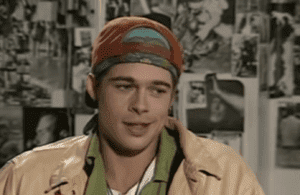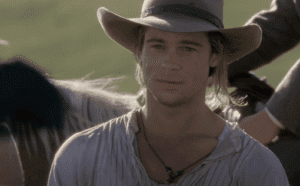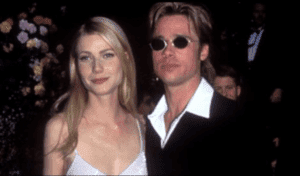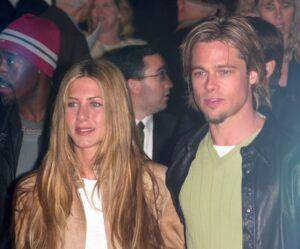Introduction
1991, Thelma and Louise careens towards the Grand Canyon, blonde locks whipping in the wind. A young man Golden Boy Young Brad Pitt behind the wheel, jaw sculpted and eyes glinting mischief, steals the audience’s hearts and a place in Hollywood history. Brad Pitt, not yet thirty, had arrived, not just as an actor, but as a cultural phenomenon. His rise to fame was meteoric, propelled by a magnetism more dazzling than the California sun. This, however, is only the first flicker in the story of a man who redefined the “Golden Boy” archetype, proving that beneath the sun-kissed exterior beat a heart of surprising depth and talent.
In this post, we rewind the clock to the era where denim jackets and tousled hair reigned, where Pitt’s every smirk sent hearts aflutter. We’ll dissect the magic behind his early days, the films that etched his name in neon, and the unexpected turns that defied the mold. This isn’t just a tale of a blonde Adonis conquering Hollywood; it’s a testament to the evolution of an icon, a man who, beyond the dazzling smile, carved a legacy as a captivating actor and an ever-evolving artist. So, buckle up, cinephiles and dreamers, as we plunge into the golden years of Brad Pitt, where legends were born and hearts were stolen, one smoldering stare at a time.

(Source: Celeb Spot/ You Tube)
Hollywood Heartthrob Before the Spotlight: Golden Boy Young Brad Pitt
Long before the roar of Hollywood crowds, Brad Pitt was just William Bradley Pitt, a farm boy in Missouri with dreams bigger than the Midwestern sky. Growing up in Springfield, he wasn’t just athletic; he was a debate team star, a musical prodigy, and a charmer in waiting. Acting wasn’t a distant Hollywood notion, but a passion cultivated in school plays and local productions.
College beckoned, and Pitt set off for the University of Missouri, journalism degree in hand. But the allure of the silver screen proved too strong. With two weeks left to graduation, he packed his car, dreams, and a heart thumping with nervous excitement, and drove west. Hollywood wasn’t kind at first. The journey was paved with rejection, couch-surfing, and bit parts in “Growing Pains” and “Dallas.” He even delivered pizzas to supplement his ramen-fueled existence. But Pitt, fuelled by grit and that Midwestern charm, kept hustling. His persistence paid off with a two-episode stint on “Another World,” followed by minor roles in films like “Less Than Zero” and “No Man’s Land.”
These glimpses on the big screen were mere whispers of the storm brewing. They were stepping stones, each rejection a lesson, each performance a brushstroke on the canvas of his burgeoning talent. The stage was set, the paintbrush poised, and the world was about to be dazzled by a blonde-haired tornado named Brad Pitt.
Rise of the Golden Boy Young Brad Pitt
In 1991, lightning struck with a desert wind in “Thelma & Louise.” Brad Pitt, the enigmatic drifter J.D., swaggered onto the screen like a mirage shimmering off the asphalt. His chiselled jawline, mischievous eyes, and devil-may-care grin ignited a supernova. The world swooned. This wasn’t just a captivating performance; it was a cultural explosion. Pitt, with his effortless charisma and smoldering intensity, had become the epitome of the Hollywood “Golden Boy.”
“A River Runs Through It” followed soon after, showcasing a gentler side to the heartthrob. Pitt’s portrayal of the sensitive, poetic Paul Maclean earned critical acclaim and cemented his acting chops. But it was “Legends of the Fall” that truly solidified his golden status. He was Tristan Ludlow, a rugged frontier icon, his tousled mane flowing in the wind as he commanded the screen with raw physicality and emotional depth. The public was smitten.
Beyond the undeniable physical appeal, Pitt possessed an intangible magnetism. His performances were infused with an effortless charm, a playful smirk dancing on the edge of danger. He wasn’t just handsome; he was captivating, unpredictable, a chameleon shifting between vulnerability and brooding intensity. Whether playing the seductive outlaw or the tortured soul, he exuded a raw, animalistic energy that drew audiences in and refused to let go.
The “Golden Boy” label clung to him like a shimmering shirt, but Pitt wore it with a casual defiance. He was more than just a pretty face; he was a talent to be reckoned with. The rise of Brad Pitt wasn’t just about sculpted abs and a winning smile; it was about an undeniable presence, a raw talent, and a charm that left the world breathless, eager to see where the legend of the Golden Boy would lead next.
Beyond the Pretty Face: Golden Boy Young Brad Pitt
While the sun-kissed looks and undeniable charisma cemented Brad Pitt’s “Golden Boy” status, his true artistry resided beneath the surface. He possessed a depth and versatility that transcended the heartthrob label, evident in a string of powerful performances throughout the 90s and beyond.

(Source: Movie Clips/ You Tube)
Deeper Shades of Golden Boy Young Brad Pitt
In 1995, audiences witnessed a stark transformation in David Fincher’s grimy neo-noir thriller, Se7en. Pitt shed his golden locks and charming persona, playing Detective David Mills, a tormented cop grappling with darkness. His raw, emotional portrayal, a far cry from the swaggering outlaw, earned him critical acclaim and proved he could navigate the depths of human psychology with nuance and intensity.
The following year, Fight Club further shattered the “Golden Boy” mold. Pitt embodied Tyler Durden, the anarchic soap salesman who ignited a rebellion against consumerism. His performance was electrifying, showcasing a captivating blend of charisma, vulnerability, and dangerous allure. It cemented his ability to inhabit complex characters who challenged societal norms and defied easy categorization.
Beyond the Silver Screen: Golden Boy Young Brad Pitt

(Source: Entertainment Tonight/ You Tube)
Pitt’s artistic pursuits extended beyond the confines of Hollywood. He co-founded Plan B Entertainment, a production company that backed critically acclaimed films like The Departed and 12 Years a Slave, demonstrating his passion for storytelling beyond his own on-screen presence. He also actively engaged in humanitarian work, establishing the Make It Right Foundation to provide sustainable housing for communities affected by natural disasters.
These endeavors showcased Pitt’s commitment to using his platform for positive change, revealing a depth and complexity that went far beyond the Hollywood heartthrob persona. He was an artist, an entrepreneur, and a philanthropist, constantly pushing boundaries and refusing to be confined by expectations.
In conclusion, Brad Pitt’s journey from Missouri farmboy to Hollywood icon is a testament to his talent, charisma, and unwavering dedication to his craft. He redefined the “Golden Boy” label, not just through his captivating screen presence, but by consistently challenging himself and venturing into uncharted territory. Beyond the sun-kissed exterior, a multifaceted artist emerged, leaving an indelible mark on cinema and proving that true stardom lies not just in beauty, but in the depth and versatility that lie beneath.
Boy Evolves: Golden Boy Young Brad Pitt

(Source: Featureflassh Photo Agency/Shutterstock)
The sun-kissed mane turned silver, the leather jackets exchanged for linen suits, but the charm, that remained, like a vintage wine, only grew richer with time. Brad Pitt, the “Golden Boy,” refused to rest on his laurels, evolving into a master chameleon, shedding his typecasting with each daring leap.
The 2000s saw him trade cowboy hats for a spacesuit in James Gray’s elegiac Ad Astra, delivering a haunting portrayal of emotional isolation. He donned a kilt as Achilles in Troy, proving his action-hero credentials while retaining a Shakespearean depth. He even explored animation, voicing the sardonic Metro Man in Megamind, showcasing his comedic range.
His style, too, mirrored this artistic restlessness. Gone were the tousled locks and ripped jeans, replaced by a sophisticated sartorial sense that defied age and convention. He sported linen suits in Ocean’s Eleven, proving a silver fox could outfox them all. In Quentin Tarantino’s Once Upon a Time in Hollywood, he channeled Old Hollywood cool in a Hawaiian shirt and a melancholic gaze.
Pitt didn’t shy away from challenging directors or gritty subject matter. He collaborated with David Fincher again in The Curious Case of Benjamin Button, defying expectations with a poignant portrayal of aging in reverse. He embraced vulnerability in Terrence Malick’s The Tree of Life, exploring existential themes with quiet grace.
These choices weren’t just artistic gambles; they were triumphs. Critical acclaim followed as effortlessly as his on-screen charisma. Awards nominations and accolades stacked up, proving that the “Golden Boy” had blossomed into a seasoned actor, captivating audiences with his raw talent and ever-expanding range.
The evolution of Brad Pitt is a testament to the transformative power of artistry. He didn’t cling to the sun-kissed image that launched him, but embraced the shadows, the complexities, the wrinkles that came with time. He didn’t just break free from the “Golden Boy” label; he shattered it, emerging as a multifaceted artist, proving that true stardom lies not in staying golden, but in continuously reinventing the light you shine.
(Golden Boy Young Brad Pitt)
Lasting Legacy: Golden Boy Young Brad Pitt
Brad Pitt’s rise to fame in the 90s wasn’t just a meteor streaking across the Hollywood sky; it was a supernova, leaving an indelible mark on pop culture and redefining the very concept of the “Golden Boy.” His impact ripples through even today, a testament to his unique charm, talent, and unwavering dedication to his craft.
Boy Redefined: Golden Boy Young Brad Pitt
The image of a sun-kissed, tousled-haired Brad Pitt swaggering across the screen in Thelma and Louise remains etched in collective memory. He wasn’t just another pretty face; he exuded an effortless charm, an electrifying blend of mischief and magnetism that sent Hollywood hearts aflutter. But Pitt, to his credit, never became a one-dimensional heartthrob. He challenged the archetype, injecting vulnerability, depth, and unexpected intensity into his performances.
Breaking the Mold: Golden Boy Young Brad Pitt
His portrayal of Tyler Durden in Fight Club shattered the “Golden Boy” mold completely. This wasn’t the charming outlaw or the romantic lead; it was a dark, anarchic figure challenging societal norms and pushing boundaries. Pitt embraced the complexity, showcasing his ability to delve into the shadows and emerge with a performance that was both disturbing and captivating.
Beyond the Silver Screen: Golden Boy Young Brad Pitt
Pitt’s legacy extends far beyond the silver screen. He co-founded Plan B Entertainment, backing critically acclaimed films like The Departed and 12 Years a Slave, demonstrating his passion for storytelling beyond his own on-screen presence. He actively engaged in humanitarian work, establishing the Make It Right Foundation to provide sustainable housing for communities affected by natural disasters. These endeavors showcased his commitment to using his platform for positive change, revealing a depth and complexity that went far beyond the “Golden Boy” label.
Enduring Appeal: Golden Boy Young Brad Pitt
Brad Pitt’s charm, unlike a fading sunset, only seems to deepen with time.
Also Read-
https://usaupdatesfirst.com/uv-doux-silicone-sunscreen-gel/

8 thoughts on “Golden Boy Young Brad Pitt: Hollywood Heartthrob 2024”
Comments are closed.